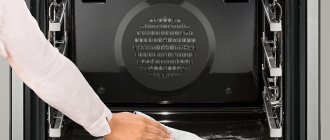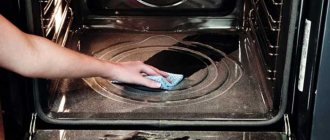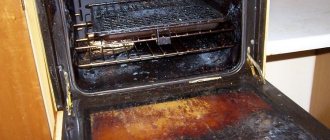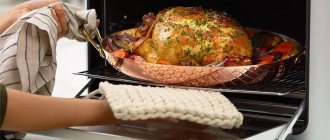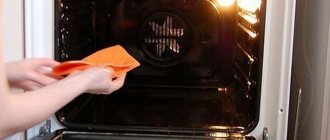Cooking in the oven is convenient; you don’t need to spend a lot of effort preparing dinner. It is enough to place the container with food in the oven and after a while you will get the finished dish.
But this convenience also has a downside - the surfaces of the baking compartment become dirty, covered with soot and grease, and are not easy to clean. Today, manufacturers offer consumers units equipped with various self-cleaning systems.
It is difficult to understand this variety and find out which oven cleaning is best. In this article we will look at what types of self-cleaning are present in modern ovens.
Traditional oven cleaning: what is it?
Traditionally, detergent and a sponge are used to clean the oven.
The traditional cleaning system is called the usual, “grandmother’s” methods. Sponges, special powders and liquids, as well as folk remedies for removing carbon deposits are used here. The disadvantages of this method are obvious:
- time-consuming and labor-intensive process;
- the need to clean trays and grates separately;
- risk of damage to surfaces.
The only advantages include energy savings and low cost of stoves that are not equipped with a self-cleaning system.
Easy-clean oven enamel: what is it?
The special coating allows you to easily clean the surface of the oven.
Easy-to-clean enamel is a smooth coating on the internal surfaces of an oven that has no pores. Grease and soot can be removed by wiping the walls with a cloth.
This coating saves the housewife from having to spend hours cleaning the oven, but still does not free her from washing surfaces by hand.
Hydrolysis or catalytic oven cleaning: what is it?
As the name suggests, hydrolysis cleaning is the dissolution of contaminants under the influence of water vapor.
To tidy up the oven, you need to place a baking tray with water in the compartment, and if it is heavily soiled, with a detergent solution. After this, the unit is turned on and warmed up for 30 minutes. If necessary, water must be added.
As a result, the dirt softens and after the oven has cooled, all that remains is to rinse the surfaces, racks and baking sheets in running water, and, if necessary, clean with a sponge. This method requires much less time and effort than regular cleaning, but the need to use a sponge and fuss with soot can be considered a definite disadvantage.
The catalytic method involves the use of special enamel for coating. This material does not allow fat to “eat” into the surfaces and harden, which makes cleaning the oven compartment easier.
FAQ
Is pyrolytic cleaning safe for children?
Make sure that when pyrolytic cleaning the oven door is well locked and the glass and handle do not heat up. If this does not happen, then there is no danger to children.
Is it worth bothering with choosing self-cleaning methods?
Good question. The self-cleaning function is quite expensive, especially pyrolytic. At the same time, you must understand that after the “impact” of this function, a person will still have to work with his hands and spend 15 minutes of time removing grease and dirt. This will be much easier to do than without the help of this function. So, when compared with each other, types of self-cleaning lead to a similar effect and the dirt simply softens, but a person still needs 15-20 minutes to remove this dirt. The difference is up to 5-10 minutes between the most expensive self-cleaning function and the cheapest. If you're not a pedant, then you probably don't need 100% cleaning. In Soviet times, ovens were generally washed once a month or six months. Are you really ready to use this function often and then spend 15-20 minutes of time?
Ecoclean oven cleaning: what is it?
Units with this type of purification appeared relatively recently. The walls of the oven are covered with special ceramics; when fat penetrates this material, it splits, turning into water and carbon dioxide. This process occurs provided that the oven is well heated.
If the walls are not cleaned enough during the cooking process, heat the empty oven for 40–50 minutes and the surfaces will get rid of plaque and soot.
The main advantage of such coatings is their service life. The self-cleaning system can maintain functionality for up to 10 years under regular use.
User voting
What type of oven would you choose or recommend?
Hotpoint-Ariston 5FA 841 JH IX
16.67 % ( 1 )
Electrolux OEF5E50X
0.00 % ( 0 )
Hansa BOEI64030030
0.00 % ( 0 )
Weissgauff EOV 19 MW
16.67 % ( 1 )
Gorenje BO735E20B-2
0.00 % ( 0 )
Bosch HBJ558YS0Q
50.00 % ( 3 )
Hansa BOEI69422
0.00 % ( 0 )
Electrolux OPEA 4300 X
0.00 % ( 0 )
Korting OKB 792 CFW
0.00 % ( 0 )
Fornelli FEA 45 Sonata
0.00 % ( 0 )
Bosch HBG672BB1F
0.00 % ( 0 )
Electrolux EZC 52430 AX
0.00 % ( 0 )
Electrolux OKD6P71X
0.00 % ( 0 )
Asko OP8676S
16.67 % ( 1 )
Pyrolytic or catalytic oven cleaning: which is better?
The pyrolytic method is considered one of the most effective. This cleaning is simply irreplaceable if the oven is used frequently.
Under the influence of high temperatures, fat simply burns, which leads to complete self-cleaning of the oven. No additional effort is required from the hostess.
The following factors can be identified as disadvantages of such a system:
- required wiring power 6 kW;
- high electricity consumption;
- high heating of the oven for cleaning (up to 500°) and heating of the entire unit itself.
When using this method of cleaning, it is better to somehow protect the furniture that is nearby from aggressive influences.
With the catalytic method, energy consumption is not so great. Special enamel promotes the oxidation of fat with its subsequent breakdown, which greatly facilitates cleaning. In addition, you can clean the surfaces during the cooking process, which cannot be said about the previous option, since it requires very high heat.
However, catalytic systems do not last forever and enamel-coated panels have to be replaced. They are designed for 300 hours of operation. In addition, the panels only protect the walls of the compartment, and everything else will have to be cleaned manually.
So, which is better: pyrolytic or catalytic oven cleaning? It is impossible to give a definite answer to this question; it all depends on the frequency of use of the baking compartment. If you cook food in the oven very often, then it will get very dirty. In such a situation, pyrolytic cleaning is the best way out.
But if you only use your oven occasionally, why the extra expense? The catalytic system will perfectly clean the unit.
Pyrolysis oven devices
In 2004, a Bosch oven was released with replaceable panels made in accordance with the latest technologies. The ceramic coating, which ensures self-cleaning of the panels, is called EcoClean.
While food is being prepared, fat penetrates into the enamel structure, which consists of cells resembling a sponge. It is then converted at a temperature of about 270 degrees into water and carbon dioxide. If the oven does not clean itself during cooking, it is recommended to turn on the oven for 40 minutes to completely clean it. During this time, the oven panels are cleaned and resume their cleaning properties.
We suggest you familiarize yourself with how to clean Light sheepskin coat
The Ecoclean coating retains its cleaning properties throughout the entire operational life of the equipment (about 10 years). In addition, panels coated with Ecoclean differ in appearance - they are thinner and painted gray. According to the manufacturer, the fat that gets on the panels breaks down extremely quickly, since it does not spread over the entire surface of the coating, but is absorbed into the enamel.
Thanks to the introduction into production of ovens with panels that can self-clean under the influence of high temperatures, housewives do not need to manually clean the ovens using a rag and powder.
Such devices are equipped with a special eco-enamel that completely covers the inner surface of the oven. To the touch, the base of the walls has a porous and slightly rough texture. The eco-enamel material is manganese, copper or cerium oxide. It is these types of catalysts that make it possible to accelerate the process of decomposition of fatty contaminants into individual components: water, carbon and organic residues. Basic moments:
- Catalytic cleaning occurs at a relatively low temperature - from one hundred forty to two hundred degrees, which is quite enough for the oxidation process.
- With the help of catalysis, an electric or gas oven can be cleaned. It is carried out right at the time of cooking, that is, there is no need to spend additional money on gas or electricity.
- The catalytic panel will have to be replaced after some time. On average, each of them is designed for three hundred hours of effective cleansing.
- Eco-enamel is located on the back and side walls, as well as on the fan blades.
- The bottom is not coated, so you will have to manually remove dirt on it and on the door.
In general, the service life of a cabinet with catalytic cleaning is between five and seven years. Since 2004, the Bosch brand has been supplying the market with eco-coated ovens EcoClean Bosch HBN 334550, which have twice the service life.
An oven with pyrolytic cleaning can only be of an electric type, since effective pyrolysis requires a very high heating temperature - up to five hundred degrees. This system is the most aggressive, but also the most effective cleaning.
During pyrolysis, natural combustion of any remaining fatty contaminants occurs until they are transformed into a small pile of ash, as in the photo, which can be swept away with a special brush or removed with a rag. The convenience of high-temperature cleaning is that you don’t need to wash anything - everything automatically burns out, even dirt on the inner surface of the door, which is locked for safety reasons and does not allow opening the oven.
If we consider the advantages of pyrolytic cleaning, it should be recognized that this method does not require disassembling the device into separate parts or removing the grill or baking sheets.
When manufacturing an electrical unit, manufacturers use only very high-quality material that can withstand high temperatures for a long time. Thus, an oven with cleaning-pyrolysis has the following undeniable advantages:
- high cleaning efficiency;
- a completely safe process;
- does not require additional manual cleaning;
- completely eliminates all formed contaminants;
- the cabinet is made from the highest quality materials;
- the use of cleaning aerosols and other chemical cleaning agents is excluded.
The decision is yours!
Which oven cleaning is better: catalytic or hydrolysis?
As mentioned above, hydrolysis is a cleaning method using water vapor, and with a catalytic system, surfaces get rid of plaque and carbon deposits due to the characteristics of the panel coating.
Both methods are used not only in electric, but also in gas units, and this is a plus.
Continuing the comparative analysis, we can say that hydrolysis saves money (there is no need to purchase cleaning agents), and the catalytic method saves physical effort when washing surfaces, since it neutralizes grease. In addition, the catalytic panels will have to be replaced over time.
Which method is better is up to the hostess to decide; in this situation, it all depends on personal preferences.
Which is better: catalytic oven cleaning or steam cleaning?
Catalytic cleaning is carried out directly during the cooking process. You do not need to run the oven additionally and waste electricity to get rid of fat and soot on the walls.
As for steam cleaning, the situation is different. The principle of operation of such a system is that fat and plaque are softened under the influence of steam. To do this, you need to place a container of water inside the compartment and preheat the oven for some time. It is impossible to combine this process with cooking. You will have to wait until the cooking is complete and the surfaces have cooled.
If we talk about financial costs, then the catalytic system will cost you more, since the panels will need to be changed periodically. And when buying an oven, you will pay more for this version of the product than for a unit with a steam cleaning function.
What type of oven cleaning is best?
What is the best type of oven cleaning? Everyone finds the answer to this question themselves. In some cases you save time, and in others you save money and electricity.
When considering various options, to make a final decision, find for yourself the answer to the question: what is more important, savings or your own comfort? Is it better for you to pay more and buy a unit with pyrolytic cleaning so as not to worry about the condition of the oven, or invest less money and still put in the effort to keep it clean?
If you use your oven occasionally, you won't have to clean it often, and an economical option will do just fine. But in any case, the choice remains with the hostess.
conclusions
We looked at all three oven cleaning systems; which one to choose is up to you. Each of them has its own advantages and disadvantages. The most often asked question is: which oven cleaning is better - steam or catalytic? Here, even experts will not be able to answer you accurately; it all depends on your individual capabilities and needs.
Here's just what you can use as recommendations:
- If you often use the oven and you are not afraid of high energy costs, then you should take a closer look at ovens with pyrolysis.
- If you rarely use your oven, then you should choose a catalytic system.
